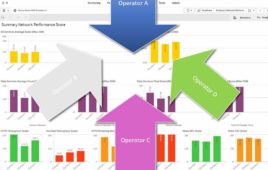Sprint is fighting back against the FCC’s proposed updates to the spectrum screen. The carrier said that by treating all spectrum as equal for screening purposes, the FCC “undermines” proposed 600 MHz auction rules that would help carriers with limited low-band licenses get a hold of 600 MHz spectrum.
The FCC has proposed limiting carriers with large low-band spectrum portfolios—primarily AT&T and Verizon—from bidding on portions of 600 MHz made available in an upcoming auction. The rules are designed to keep the two largest U.S. carriers from “sweeping” the auction, Sprint wrote.
Sprint representatives met with the FCC and pointed out the apparent double standard, specifying that the Commission’s actions suggest that “low-band spectrum is so competitively important that it warrants a 600 MHz reserve for carriers with limited low-band spectrum, yet the staff recommends that all spectrum (including low-band) count equally in a revised spectrum screen.”
The FCC recently proposed adding 128.5 MHz of airwaves to its spectrum screen, and 101 MHz of that spectrum belongs to Sprint. Sprint pointed out in an FCC filing that under the current nationwide screen, the carrier doesn’t exceed the FCC’s current 151 MHz threshold in any counties, while AT&T exceeds it in 178 counties (5.5 percent of the total).
Under the new proposal that moves the threshold to 194 MHz, Sprint would exceed the screen in 797 counties (24.7 percent of the total), while the other three largest carriers would exceed the screen in zero counties. Sprint said the new spectrum screen would put it over the threshold in markets representing more than 65 percent of the U.S. population.
Sprint said the FCC’s proposal would grant AT&T nearly triple its current spectrum screen headroom and almost double Verizon’s current headroom while, on average, eliminating Sprint’s headroom. Sprint argues that it couldn’t even make “routine” spectrum transactions without detailed analysis under the new screen, which the carrier said would position Sprint as the carrier with the dominant national market power.
“This, of course, is preposterous,” Sprint wrote.
To that end, Sprint has proposed a three-tier weighting approach to the spectrum screen: Spectrum below 1 GHz would be counted as 1.5, spectrum between 1 GHz and 2.2 GHz would be counted as 1, and spectrum above 2.2 GHz would be counted as 0.5.
“Building on the fundamental principles of Sprint’s original proposal, this simplified weighting version supports a more logical competition-based screen than the Commission staff proposal,” Sprint wrote in an FCC filing.
Sprint’s original spectrum weighting proposal took into account different weights for spectrum covering rural, suburban and urban areas.
Sprint’s proposed weighting system would go a long way toward limiting the impact of the carrier’s large holdings in the 2.5 GHz band, which is acquired when it last year bought out Clearwire.
In the wake of that transaction, both AT&T and Verizon have urged the FCC to include Sprint’s new, vast 2.5 GHz holdings in the spectrum screen. Sprint has stressed the importance of that spectrum to its Spark LTE broadband network.




